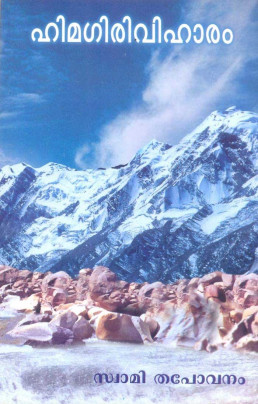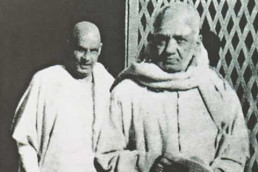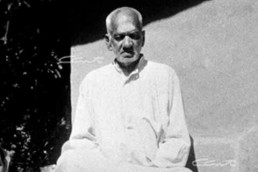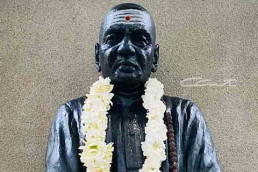
T.N.K Pillai
Sri T.N. Kesava Pillai was the person who translated Swami Tapovanam’s Malayalam book Himagiri Vihar into ‘Wanderings in the Himalayas‘ as we know it today. He also translated the Sanskrit book Ishwara Darshanam from its Malayalam translation done by Swami Mridananda of Sri Ramakrishna Ashram, Vilangan. We are very happy to reproduce this article in which he shares some of the insights he gained in the process of translating Himagiri Vihar.

By T.N.K Pillai
Sri T.N. Kesava Pillai was the person who translated Swami Tapovanam’s Malayalam book Himagiri Vihar into ‘Wanderings in the Himalayas‘ as we know it today. He also translated the Sanskrit book Ishwara Darshanam from its Malayalam translation done by Swami Mridananda of Sri Ramakrishna Ashram, Vilangan. We are very happy to reproduce this article in which he shares some of the insights he gained in the process of translating Himagiri Vihar.
Books are written with different motives. Some are composed for fame; some are written for money; a few others are written for the edification of the soul. To the last class belongs His Holiness Swami Tapovanamji’s Himagiri Vihar.
As the title suggests, it is a book of travels. But a cursory glance at its contents is enough to reveal that it is much more than an account of explorations. Swamiji’s rambles among the Himalayas form its framework, but it is only a framework. Its main contents are the spiritual experiences of a holy life devoted solely to the pursuit of Truth. The book does not belong to the class of modern travelogues, full of interesting, but superficial information, for it was not designed to cater to the idle curiosity of multitudes. It cannot be classed even with the thrilling descriptions of mountaineering adventures like The Epic of Mount Everest or Eric Shipton’s Upon that Mountain. The approach is different; the treatment is different; the basic idea itself is different.
To the Hindus, the Himalayas are not just a row of mountains forming an impregnable fortress along the northern border of their beloved motherland. It is for them the home of spirituality. In a sense, the Himalayas are to the Hindus what Olympus was to the ancient Hellenes. From immemorial times, the Himalayas have been the retreat of our Rishis who renounced the world at a ripe age and withdrew into a life of serene contemplation. Like a lode-stone, Himalaya has drawn to its bosom spiritual aspirants from all parts of the country, generation after generation. It is therefore no wonder that a spiritual genius like Swami Tapovanamji Maharaj was drawn to it irresistibly in the very prime of his life.
Swamiji was hardly thirty-four when he took up his abode in the Himalayas about thirty-four years ago. Until he entered mahasamadhi just twelve months back, he passed his days there in study and meditation, now teaching apt pupils, now treading through dangerous forests and still more dangerous snow fields, scaling steep mountains and descending into deep gorges and visiting places of pilgrimage like Kailas, sometimes again and again. His strange and wonderful experiences during these journeys and the lofty thoughts that suggested themselves to him from day to day during his perambulations are embodied in splendid language in his unique book, Himagiri Vihar.
Unlike most of his learned works like Ishwara Darshan and Saumyakaseesa Stotram, Himagiri Vihar is written in his mother tongue, Malayalam. The first part of the book saw light in book form sixteen years ago. It contained accounts of his visits to Rishikesh, Uttarkasi, Yamunotri, Gangotri, Kedarnath, Badrinath and Saradapeetham in Kashmir. The second book, published two years later, describes Swamiji’s visit to Amarnath, Jwalamukhi, Lake Reewal, Manikarnika, Vasishtha, Triloknath, Pashupatinath, Chandananath, Khocharanath, Lake Manasa and Kailas. The last volume deals with Dolingamadham, Kailas (second visit), Manasa, and Sree Gomukham. All the three volumes manifest the author’s Wordsworthian love of Nature and Man and his matchless power of description. As in the Ode to Tintern Abbey, his descriptions often shade off into the infinite and he enters into the blessed mood described by Wordsworth:
“In which the burden of the mystery,
In which the heavy and weary weight
Of all this unintelligible world
Is lightened – the serene and blessed mood,
In which the affections gently lead us on
Until, the breath of this corporeal frame
And even the motion of our human blood
Almost suspended, we are laid asleep
In body, and become a living soul;
While with an eye made quiet by the power
Of harmony and the deep power of joy,
We see into the life of things.”
In the course of this mystic experience, he felt like the poet:
“A sense sublime
Of something far more deeply interfused,
Whose dwelling is the light of setting suns
And the round ocean and the living air,
And the blue sky and in the mind of man;
A motive and a spirit that impels
All thinking things, all objects of all thought,
And rolls through all things.”
There was only one difference but how important between them. In the case of Wordsworth, as youth vanishes and he becomes a man, “the vision splendid” “fades into the light of common day”. In the case of Swamiji, on the contrary, the vision grows clearer and clearer as the years roll on, and the differences between Man and Nature and God fade away and they all merge into One without a second.
Swamiji’s descriptions are extremely vivid. Often they reach the sublimity of Miltonic poetry. The author appears to be a poet turned hermit. As for the narratives, they are as interesting as a novel and as thrilling as a drama. The thoughts interspersed among them are like sparkling gems set in flowers of gold.
Swamiji’s style is not simple; it could never be. The loftiness of his language is the loftiness of thought and they cannot be divorced without damage to both. Though he knew English and was acquainted with Western philosophy, his thoughts were formed in the Sanskrit mould. For, he was at home more in the language of the Vedas than even in his mother tongue. Himagiri Vihar is an asset to any language; it is specially so to Malayalam.
Previous Topic
Light of the Himalayas
This article by Swami Sivananda about Swami Tapovanam was originally published in a Shraddhanjali Souvenir in the year 1958…
Next Topic
Monk and the Dacoit
The way to mount Kailas was long and lonely; it was touched by eternal silence. One day, through this lonely region, a monk…
Home Page
Homage to Sri Swami Tapovanam
The 50th anniversary edition of Tapovan Prasad (December 2011) was entirely dedicated to our Paramaguru Swami Tapovan…


